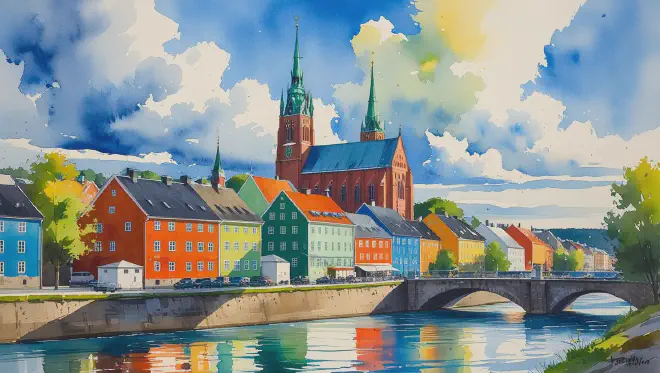Introduction
Trondheim, nestled in central Norway, is an ancient city founded over a thousand years ago by Viking kings. Once called Nidaros, it served as the capital of the Norwegian kingdom, flourishing as a center of power and culture. Today, the magnificent Nidaros Cathedral still towers over the city center, while cobblestone streets whisper tales of centuries past.
This city facing the Trondheim Fjord is also a beautiful harbor town where colorful wooden architecture reflects in the waterside. In the old town district of Bakklandet, red, yellow, and blue painted wooden warehouses line the riverbank, creating a scene that feels like stepping into a storybook. In modern times, Trondheim is known as an academic city, centered around the Norwegian University of Science and Technology, where youthful energy harmonizes with deep history to create a unique atmosphere.
At the boundary between the brief Nordic summer’s end and the long winter’s beginning, I decided to visit this city.

Day 1: Footsteps on Cobblestones and Layers of Time
Landing at Trondheim Værnes Airport just after 10 AM on a morning flight from Oslo, I took the airport bus toward the city. Through the window, endless coniferous forests stretched out, dotted with red-roofed houses—a quintessentially Norwegian landscape that quietly settled my heart.
Arriving in the city center, the first sight that struck me was the imposing presence of Nidaros Cathedral. Its stone spires reached toward the sky, bathed in morning sunlight. After checking my luggage at the hotel, my feet naturally carried me toward the cathedral.
Construction of this cathedral began in the 11th century, making it Norway’s largest medieval structure. The beautiful Gothic facade is adorned with carefully carved sculptures of saints. Stepping inside, light streaming through colorful stained glass windows created fantastical patterns on the floor. Watching local people quietly offering prayers before the altar, I felt how this place continues to serve as spiritual support for the community.
In the afternoon, I wandered through the old town of Bakklandet. The colorful wooden buildings along the Nidelva River once served as merchants’ warehouses. Now converted into restaurants, cafes, and shops, they retain their historic character. While tourists took photos in front of the red buildings, the overall atmosphere remained quiet and peaceful on this weekday afternoon.
The view of Bakklandet from Gamle Bybro, the old wooden bridge crossing the river, was breathtakingly beautiful. The buildings’ colors reflected in the water created a scene like a painting. Standing on the bridge, absorbed in the vista, an elderly local man approached me.
“Beautiful, isn’t it? I’ve lived in this city for seventy years, but seeing this view still makes my heart leap.”
His English carried a slight Norwegian accent, but his warm tone conveyed deep love for his hometown. He shared memories of swimming in this river as a child and watching adults work in the warehouses—stories of the city’s living memory.
For dinner, I visited “Fagn,” a restaurant recommended by locals. Known for modern Nordic cuisine using local ingredients, it had an excellent reputation. The appetizer was Arctic scallop carpaccio—the shellfish’s fresh sweetness harmonized beautifully with dill’s refreshing aroma. For the main course, I chose Norwegian venison, its juicy texture perfectly complemented by juniper berry sauce, truly capturing the essence of Nordic forest bounty.
Through the restaurant window, I could see the town in twilight. People walking on cobblestone streets, the warm glow of orange streetlights—I wondered if residents from a thousand years ago gazed upon similar evening scenes. Time passed slowly as I pondered such thoughts.
Walking back to the hotel, I passed the cathedral again. Illuminated against the night sky, the building revealed a mystical beauty different from daylight. What discoveries would tomorrow bring? With anticipation in my heart, I left the quiet nighttime streets behind.
Day 2: Nature’s Symphony and Human Endeavors
Waking at 7 AM, the world outside my hotel window remained dim. Nordic autumn brings late sunrises. After leisurely preparing, I headed to the hotel’s breakfast room.
A typical Norwegian breakfast awaited. I started with the classic open-faced sandwich—smoked salmon, cream cheese, and dill on rye bread. Each ingredient’s flavor harmonized perfectly, creating an elegant Nordic taste. Paired with warm coffee, it warmed me from within.
Just after 9 AM, I set out for Kristiansten Fortress, today’s destination. This star-shaped fortress from the 17th century sits atop a hill about fifteen minutes’ walk from the city center. Climbing the slope and looking back, Trondheim’s cityscape spread out below. The colorful rooftops created a patchwork-like vista.
At the fortress, a local guide explained its history. Built to defend against Swedish invasion, it actually experienced several battles. Standing within the thick stone walls, I could almost feel the tension of those times.
The view of Trondheim Fjord from the fortress was exceptional. The calm water surface reflected distant mountains, while small fishing boats occasionally passed by quietly. After enjoying the scenery for thirty minutes, I decided to return to the city.
In the afternoon, I visited Rockheim, a popular music museum. This modern museum showcases Norwegian popular music history and features a distinctive building that juts out into Trondheim Fjord.
Inside, I could experience Norwegian music scenes from the 1950s to present. From internationally known artists like a-ha and Kings of Convenience to locally beloved traditional music, the exhibits covered a wide range. Particularly impressive was the section on “joik,” the traditional Sami singing style. This ancient vocal technique expresses natural sounds through voice, and listening to it conjured visions of the Nordic wilderness.
I had a late lunch at the museum cafe. The Norwegian fish soup was wonderfully warming—fresh white fish and root vegetables in a creamy broth that heated me to my core. Dipping bread into it increased my satisfaction even more.
In the evening, I explored the local market “Torvet.” Fresh seafood, local vegetables, and handmade cheeses lined the stalls. The market vendors were all friendly, eagerly explaining their products. At the cheese shop, I sampled a Norwegian blue cheese specialty—rich, full-bodied, with a distinctive saltiness.
“This is a recipe we’ve been making since my grandfather’s time,” the shopkeeper said proudly. “We use milk from mountain-raised cows and age it using traditional methods.”
I purchased some of that cheese and enjoyed it on a nearby park bench while watching the sunset. The western sky turned orange, its light shimmering across Trondheim Fjord’s surface. Being a weekday evening, the park was filled with people returning from work, taking walks, or resting on benches. I felt naturally absorbed into this peaceful slice of daily life.
That night, I enjoyed craft beer at “Mikrobryggeriet,” a local pub. This small brewery produces its own beer and is beloved by locals. I ordered an IPA—perfectly balanced hops with pleasant bitterness and aroma.
I had a chance to chat with a young local sitting nearby. He was studying engineering at Trondheim’s university.
“Trondheim is a small city, but very livable. Nature is close by, people are kind, and there’s an international atmosphere too. I think you’ll really like it.”
His words rang true—this city possessed special charm. History and modernity harmonized, nature and culture coexisted. The city’s night was filled with quiet yet warm vitality.
Day 3: Morning Farewells and Lasting Impressions
On my final morning, I rose early to witness the city’s dawn expression. At 7 AM, walking the still-quiet cobblestone streets, the aroma of fresh-baked bread wafted from bakeries. Through cafe windows, I saw locals reading newspapers over morning coffee.
Walking along the Nidelva River, I burned the Bakklandet scenery into my memory once more. In morning light, the colorful buildings appeared even more vivid. Thin mist hung over the water, creating an ethereal atmosphere. Standing on the bridge, I took a deep breath and etched this moment into memory.
After returning to the hotel for breakfast, I visited the Archbishop’s Palace (Erkebispegården) as my final tourist destination. The ruins of the medieval Norwegian archbishop’s residence now serve as a museum, displaying medieval household items and religious artwork that glimpse into period life.
Particularly moving were the beautiful 12th-century sculptures. The saints carved in stone remained vivid despite centuries passing. According to the guide, these sculptures represented the highest technical standards of their time, crafted by artisans gathered from across Europe.
“Medieval Trondheim was the cultural center of the Nordic region. Coming here meant accessing the latest art and technology.”
Hearing such stories, I felt anew the cultural depth this city possessed.
For lunch, wanting to experience local home cooking one last time, I chose “Sjøbua,” a traditional restaurant. Their specialty was “rakfisk,” a traditional fermented fish dish from northern Norway. Though warned it was an acquired taste, I decided to try it.
The dish looked like ordinary fish, but had a distinctly unique flavor—complex umami from fermentation that initially surprised me but gradually became addictive. Knowing locals had passed down this taste through generations made the experience feel particularly special.
At 2 PM, departure time arrived. After one final look at Bakklandet, I boarded the airport bus. The scenery through the window should have been identical to my arrival three days earlier, yet somehow appeared completely different. The familiar coniferous forests and red-roofed houses all seemed precious.
While checking in at the airport, I reflected on these three days. Nidaros Cathedral’s solemnity, Bakklandet’s beautiful scenery, the fjord vista from the fortress—and above all, the warmth of people I met. The cheese vendor’s proud smile, the student’s candid words, the elderly man on the bridge sharing his love for the city.
Looking down at Trondheim from the airplane window, the city appeared small but undeniably real. Surely people still walked those cobblestone streets, someone sipped coffee at the riverside cafe, and prayers were quietly offered in the cathedral.
Epilogue
This journey exists only in imagination. I never actually walked Trondheim’s cobblestones, never prayed inside Nidaros Cathedral, never witnessed Bakklandet’s colorful buildings with my own eyes, never exchanged words with local residents.
Yet this journey genuinely occurred within my heart. The brief Nordic autumn sunlight, ancient building colors reflected in the river, the distinctive taste of fermented fish, and above all, the gentle, warm atmosphere of this ancient harbor town—all continue living in my memory.
Though imaginary, this journey feels authentically real. Perhaps this represents another form of reality, woven from longing for a place and the power of imagination. When I someday truly visit Trondheim, these imagined memories will overlap with reality, creating an even richer experience.
Travel isn’t solely about physical movement. When the heart moves, imagination expands, and we touch new worlds—this too represents a genuine form of journey.

